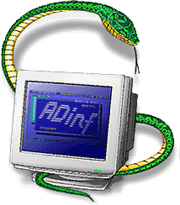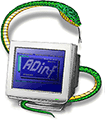|
|

|
ADinf is a unique and powerful disk integrity checker which scans a disk, reading its sectors one by one
without assistance of operating system. Its mission is wider than mere anti-virus protection - besides
detecting infectors, ADinf scrupulously evaluates a system for full data integrity and security,
and for other data modifications. First ADinf version was developed in far 1991 for MS-DOS.
Than variants for Windows 3.xx, and Windows 9x/NT were released. Now ADinf32 supports all mordern
Windows family operating systems (with only exception for Windows Vista) and all Microsoft file systems:
NTFS, FAT (all types), exFAT, .
|

|
|
|
Disk inspector and integrity checker ADinf
was developed for the operating systems MS-DOS and Windows 95/98.
This is a further development of the first version of disk integrity checker called Dinf (Disk Informator),
created by Dmitry Mostovoy back in 1989, at the dawn of viruses.
ADinf has been a reliable tool for detecting both known and new, unknown viruses.
It was and today remains the only disk intedrity checker in the world that checks file systems by reading sector-by-sector
through direct computer BIOS calls. The ADinf inspector became widely famous when it became the only program in the
world that detected the sensational and highly destructive DIR-II virus immediately after its appearance.
|
ADinf user guide'1996
|
|
Results of the creation of the integrity checker ADinf were reported at a conference in Boston, USA, in 1995.
Conference materials: Dr. Dmitry Mostovoy.
Modern Methods of Detecting and Eradicating Known and Unknown
Viruses. - 5th international conference VB-95
(Virus Bulletin - 95), 20-22 September 1995.
|
|
|

|
ADinf for Windows was a 16-bit application designed for Windows 3.xx operating system.
|

|
ADinf32 is a new generation of disk inspectors and integrity checkers.
Although ADinf32 inherited the fundamentals from its predecessor,
well-known disk inspector ADinf, it's an absolutely new product that offers you a variety of new features:
- ADinf32 is built around a true 32-bit multi-thread architecture.
- ADinf32 offers a modern friendly user interface.
- ADinf32 can check your system in asynchronous mode.
This means that you can view the scan results for one drive, while
other drives are being scanned, which makes the check process less
time-consuming.
- ADinf32 is able to parce macros in MS Word and Excel documents and detect macro-viruses.
- ADinf32 implements the fast CRC check of the following file formats:
- COM (MS-DOS COM-executable files),
- MZ (MS-DOS EXE-executable files),
- NE (Windows 3.xx executable files)
- PE (Windows 9x/NT/XP/Vista executable files),
- LE (VxD).
- ADinf32 correctly handles double changes in the file system, such as "file renamed and modified" or
"file moved to another folder and then modified".
- ADinf32 detects companion viruses.
- ADinf32 offers flexible check levels. If you are familiar
with ADinf, you probably know that you can mark a folder
as "working", which means you do not wish to monitor
the changes in this folder. ADinf32 makes a step further, offering
you an opportunity to assign check attributes to an individual file, not only to a folder.
- ADinf32 lets you dynamically filter the scan results
displayed on the screen and immediately updates the scan statistics when you change the filter.
- ADinf32 detects and correctly handles changes in the file system when disk scan
takes place in the multi-task environment.
- ADinf32 keeps and analyzes the global history of all disk changes.
- ADinf32 supports all Microsoft file systems: NTFS, FAT (all types), exFAT.
|

|
ADinf32 Pro is a special modification for users who demand guaranteed integrity and security of large
volumes of valuable information, for example, databases or document archieves. Because of a new LAN64
algorithm used for computing the checksums of files, ADinf32 Pro is not a simple integrity checker,
but a powerful utility which keeps strict control over data security.
LAN64 algorithm computes 64-digit checksums with the hash function developed by Russian company LAN Crypto, Ltd.
for controlling the security of specially valuable information. It guarantees reliable control over data security and
leaves no room for modification of files without changing the value of the hash function.
Under CRC16 and CRC32 algorithms employed in standard ADinf32 versions, the checksums of files can be algorithmically
modified so as to introduce slight modifications in files. In this sense, CRC16 and CRC32 checksums are helpless
against smart tricks. For both these CRC types, there are algorithms which compute additional bytes so that
checksum remains unchanged.
The LAN64 algorithm (hash function) is intelligent enough not to permit anyone to compute the necessary changes
without altering the checksum. Trial-and-error method is only way and this cannot be accomplished in real time.
Here lies the superiority of LAN 64-digit checksum.
|

|
The new generation of ADinf32 (Gen 2) is designed to work with modern huge disks containing millions of files,
and for working with removable USB drives and flash drives.
The first version of the 2nd generation was released in October 2022.
Keeping everything its unique features such as reading and parsing file systems (all types of FAT, NTFS and exFAT)
at a low level, by reading by sectors, ADinf32 got the ability to work with disks containing
over a million files. This was achieved through a deep reworking of the core of the auditor. In addition, added
the ability to exclude files and directories from scanning by long name masks, exclude directories by full paths
or, conversely, include only selected directory trees in disk snapshots and control the safety of important information
on huge disks without spending a lot of time.
The new generation supports a special mode of control over the safety of information on removable media, such as USB disks
or flash drives that everyone has. In the disk settings for a flash drive, you can enable the mode of saving a snapshot in the root of the disk.
In this case, a copy of the snapshot and the exported settings profile will be saved in the root directory. On any other computer
you can check the safety of the information on the flash drive and, having written the new information, update the root snapshot. When the flash drive
returns to its "native" computer, it is automatically checked against the snapshot previously saved on the computer, which allows
see all the changes in the data that have occurred during her "walk around other computers". This significantly reduces the risk
bring the virus on a flash drive.
|
|
|

